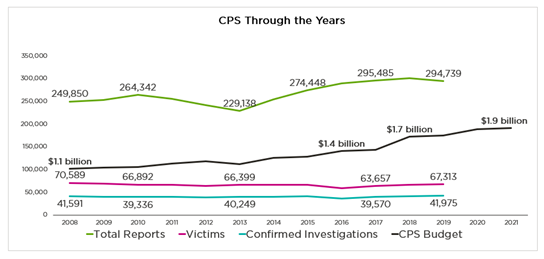The work of the 87th Legislature is already well underway, and TexProtects’ staff is hard at work alongside agency and legislative leaders in ensuring that Texas keeps child safety and family wellbeing at the top of the priority list this session.
Late last month, TexProtects provided recommendations in response to the Department of Family and Protective Services’ (DFPS) Legislative Budget Request (LAR). The agency’s LAR will serve as the foundation for the appropriations bill and state budget for 2022 – 2023. With the ongoing challenges of COVID-19 and the prospect of a session much more limited in scope, now more than ever, public participation and feedback on the budgetary process is critical to ensuring that communities and families can benefit from strategic investments and proven programs that ensure every child has a bright tomorrow.
You can read our comments and recommendations here, and stay tuned for more opportunities to let lawmakers know that now is the time for us all to step up and be champions for children.
TexProtects’ Stakeholder Input Department of Family and Protective Services Legislative Appropriations Request 2022-2023
Submitted November 24, 2020
TexProtects appreciates the opportunity to offer comment on the Department of Family and Protective Services’ Legislative Appropriations Request for 2022-2023. As the only statewide organization singularly focused on child protection and preventing abuse and neglect, we applaud the Department’s investments in prevention and family preservation approaches that are proven to keep children safe and keep families together.
Investments by the 85th and 86th Legislatures and innovative approaches by DFPS leadership have resulted in substantial shifts in approach that have the potential to change the landscape of child welfare in Texas in a way that is beneficial for children and families. The rollout of Community Based Care and the potential funding available through the Family First Prevention Services Act offer Texas the opportunity to invest in proven strategies, leverage community strengths, and keep kids safe.
However, despite these significant improvements, the DFPS budget still reflects a prioritization of reaction to abuse and neglect rather than prevention and family preservation. Only 5% of the 2021 budget is spent on prevention with 87% spent on Child Protective Services. The investments in CPS have increased much faster than investments in prevention without any accompanying decreases in reports, investigations, or confirmed victims.

Texas has not created a system that is effectively rolling out evidence-based practices to prevent removals and address risk before a crisis.
- Despite increasing child fatalities resulting from child abuse and neglect (specifically in children under age 5), only 3.8% of families in highest need have access to voluntary evidence-based programs through the Prevention and Early Intervention Division that could help prevent such tragedy.
- The vast majority of investigations are for neglect rather than abuse, demonstrating that most families are need of support rather than protection.
- 78% of removals from the home (and entry intro foster care) are occurring straight from investigations without the family receiving family preservation services.
- 42% of families who have received services in Family-Based Safety Services (FBSS), which are intended to prevent removals, are re-reported for abuse or neglect within five years of completing services.
- 44% of children are subsequently alleged as a victim in a new investigation within five years of exiting CPS custody.
- Disparities by race persist with African-American families 1.9 times as likely to be investigated and African-American children 1.6 times as likely to be removed than Anglo children.
Impact of the COVID-19 Pandemic on Child Abuse and Neglect
Now more than ever, it is critical that the state respond correctly and provide families with proven strategies to meet their needs and to stay together safely, otherwise there is a risk of putting more stress on the system. The COVID-19 pandemic has not only negatively impacted Texas’ budget, it has caused families to face an unprecedented amount of stress, financial difficulties, and social isolation. Research during the Great Recession found significant correlations between unemployment and physical and emotional abuse. If those correlations hold in the current crisis, Texas could see a 15% increase in physical abuse cases and 12% increase in emotional abuse cases for every one-point increase in the unemployment rate.

For many families experiencing unemployment, untreated substance use and mental health challenges can increase the risks to child safety and family well-being. According to the Meadows Mental Health Policy Institute, a 5% increase in the unemployment rate could result in 300 additional lives lost to suicide, 425 additional lives lost to drug overdoses, and an additional 50,000 cases of Substance Use Disorder each year. With more than 70% of CPS cases involving mental health and substance abuse challenges prior to COVID-19, we expect to see an even more substantial impact.
Now more than ever, protecting children requires better support for families who are facing unprecedented challenges that can impact child safety and well-being.
DFPS’ Legislative Appropriations Request (LAR)
DFPS is entering into the next biennium with a $4.5 billion baseline request, which reflects growth forecasts but is impacted by the previous 5% reductions. According to DFPS, this required making some additional funding asks just to get back to a maintenance level of operations. In a typical legislative budget cycle, one would expect numerous exceptional items above DFPS’ baseline request. However, with the current economic climate amid a pandemic and a costly ongoing federal lawsuit, DFPS’ approach to the budget is narrow in scope and only aimed at initiatives they consider to be most necessary. DFPS’ LAR includes requests for an additional $192 million to carry these out.
It is promising to see two opportunities for additional prevention investments to keeping families safely together and preventing removals reflected in the Exceptional Item Requests.
- $10 million is requested for investment in Prevention and Early Intervention (PEI) services, specifically Project HOPES (Healthy Outcomes through Prevention and Early Support), the Family and Youth Success Program (formerly known as STAR), and the Military Families Program. Citing the costs of each program in comparison to the cost of foster care services, DFPS acknowledged these services as a “cost-effective alternative to foster care.”
- DFPS also included a placeholder to discuss how to leverage the funding opportunities in the Family First Prevention Services Act (FFPSA).
These initiatives and associated dollars are focused on keeping children safe and supporting families to ensure that reports, investigations, and child abuse/neglect rates decrease. The only path toward a better Texas tomorrow and decreasing costs spent on CPS is to shift the paradigm by investing in cost-effective and proven programs BEFORE crisis. Prevention saves dollars and make sense. It’s the right approach for children and the smart approach for taxpayers.
TexProtects’ Recommendations
1 Exceptional Item Request #4 – Fully fund Prevention and Early Intervention toward Strategic Growth
While the CPS system plays a vital role for children who have endured abuse and/or neglect, the Department of Family and Protective Services (DFPS)also plays a critical role in the prevention of abuse and neglect and the strengthening of families through effective prevention programs. The Prevention and Early Intervention Division at DFPS has established innovative and effective community-based strategies for delivering proven programs to families who choose to enroll.
The immense research done on the health implications of Adverse Childhood Experiences (ACEs)[i]—including abuse, neglect, family violence, or growing up with a caregiver who is incarcerated, mentally ill, or engaging in substance use—makes clear that what happens in early childhood literally lasts a lifetime. The prevention of ACEs holds incredible potential for ensuring healthy development and impacting societal challenges and taxpayer costs across multiple domains.
The cost of inaction is clear. ACEs like child abuse and neglect are associated with negative outcomes for individuals across the lifespan including poorer health, lower educational attainment, and higher likelihood of experiencing unemployment. Individuals and governments incur significant costs as a result. Bellis et al. (2019) estimate that annual healthcare costs attributable to ACEs across North America are approximately $748 billion with 82% of costs resulting from individuals who had two or more ACEs.[ii] With one in 10 American children living in Texas, we can expect to incur a significant percent of those costs if we aren’t better able to prevent child abuse, neglect, and other severe childhood trauma.
To create the most effective and efficient systemic change, interventions should occur in early childhood and should rely on evidence-based approaches that decrease risk and increase protective factors within family and community systems.
- We fully support the DFPS request in exceptional item #4 to increase investments in prevention initiatives including Project HOPES (Healthy Outcomes through Prevention and Early Support), the Family and Youth Success Program (formerly known as STAR), and the Military Families Program.
Specifically, we applaud the increase in Project HOPES and the Military Families Program which have implemented evidence-based home visiting strategies for families with young children. These programs are proven to have significant impacts on maternal and child health, school readiness, and child safety during the most critical years for development and have been a lifeline for families during the COVID-19 pandemic.
HB1549 (85R) directed the agency to create a strategic plan to scale prevention programming. The current PEI strategic plan indicates that to adequately protect families, a 20% increase in prevention funds is needed every biennium.
While this exceptional item does reflect a 6% increase for PEI budget and an 11% increase in the number of families who could be served by PEI, it still offers less than 4% of families with young children and 3 or more risk factors access to proven evidence-based home visiting.
- In order to maximize impact, ensure access for families in need, and realize savings across our state systems in this budget cycle and the many yet to come, our investment must demonstrate a true commitment to strategic expansion.
$18 million additional dollars (on top of the request) would allow Project HOPES to expand so that they could reach at least 5% of families most likely to benefit, would be more in line with the growth goals in the PEI strategic plan, and would create a meaningful path toward statewide scale of proven prevention programs.
2 Exceptional Item Request #5 – Prioritize Prevention in Appropriating Funds for Family First Prevention Services Act (FFPSA)
FFPSA provides Texas with a tremendous opportunity to transform the system from one that primarily responds after a crisis has occurred to one that invests in prevention to ensure families can remain together when safe and appropriate, have the supports they need, and avoid the trauma of a removal. In fact, FFPSA is the greatest investment and shift in the child welfare system from the Feds in the past five decades and if Texas doesn’t act, we will miss out on the opportunity to shrink our foster care system. FFPSA creates a funding mechanism for prevention services so that states can now be reimbursed at a rate of 50% for trauma-informed and evidence-based substance use, mental health, and in-home parenting services that have been approved by the Title IV-E Prevention Services Clearinghouse. Federal eligibility criteria broadly include children at imminent risk of entering foster care and their caregivers, as well as pregnant or parenting foster youth. The goal is to keep children out of the Child Protective Services (CPS) system by utilizing providers in the community who specialize in prevention.
DFPS released their strategic plan on September 1, 2020 which includes an overview of existing prevention services and agency activities that align with FFPSA, as well as implementation considerations and options for the prevention services and congregate care components of the bill using federal dollars already in hand from the Family First Transition Funds Act (FFTA). The plan does not require additional appropriations from the 87th Legislature and does not propose investment of any state dollars to receive the federal match that FFPSA affords. It does little to set up a framework for how to take advantage of this potentially transformational federal funding on an ongoing basis; therefore, there will still need to be planning in the 88th Legislature if this is not addressed now. Much can be done now to ensure Texas leverages this federal legislation and funding opportunities. The Department is awaiting direction from the 87th legislature on how to spend the recommended $33.9 million on prevention services for families whose children are at imminent risk of entering foster care.
- Support the Department’s plan to leverage $33.9 million in FFTA funds toward prevention efforts.
The prevention provisions of FFPSA are ultimately optional, so the Department’s plan to use $33.9 of the $50.3 million in FFTA funds on prevention efforts shows great promise. Prior to FFPSA, states focused dollars on measures that are expensive and reactive rather than proactive, protective, and cost-efficient. The further into the system a case flows, the more expensive it is. In 2019, there were 18,615 children who entered foster care. Preventing 3% of those removals would save the state $20 million. By investing earlier, Texas can prevent removals, save money, and keep children safe.

- Prioritize effectiveness and be strategic about which prevention options to pursue.
DFPS laid out a wide range of options in their strategic plan. In partnership with lawmakers during this session as well as future sessions, it is essential to identify which strategies are most effective and can be replicated well in diverse communities around the state.
The most promising options leverage the expertise that has been developed within DFPS’ PEI division. These services are not staffed or carried out by employees of DFPS. Instead, PEI contracts with community providers who are highly-skilled in prevention work to provide voluntary services. Similar approaches can be utilized to fund community block grants and targeted approaches to reach families at higher risk while still empowering community leadership, strengths, and choice.
Options 2D, 2E, and 2F in the FFPSA plan are most poised to deliver proven programs to the FFPSA defined population in the coming biennium and as written could offer pilot programming to over 3,000 families at risk of removal including pregnant and parenting foster youth.
These options leverage established and successful infrastructure and programs with experience, serving FBSS families, who fit the eligibility definition. Additionally, several of the programs already implemented by PEI are approved by the Clearinghouse, including Healthy Families America, Nurse-Family Partnership, and Parents as Teachers and could be used to draw down the federal match.
Increased investment in those three options from available FFTA funds could empower pilots in more communities as well as exapnsion into rural communiites through tele-health and in-person modalities. A more focused investment in pilot approaches most likely to succeeed would result in closer to 5,000 families served before the next legislatative session. This would provide the next legislature more information to decide how and where state general revenue investments could be most impactful to communities and the budget by maximizing the federal match.
- Strengthen family preservation services.
Family-Based Safety Services (FBSS) is the stage of service within DFPS that is tasked with providing services to families who have experienced child abuse and neglect but that has not risen to the level of requiring a removal. This stage of service is meant to keep families together and strengthen their ability to be healthy without further CPS intervention.
DFPS has proposed that families participating in FBSS are one of the primary targets for FFPSA prevention services. Unfortunately, DFPS does not publicly report which supports and services are provided to these families. Anecdotally, DFPS has shared that these services are primarily not evidence-based. FFPSA provides an opportunity to do something different by providing these families with evidence-based, trauma-informed services.The state spent $94 million on FBSS to serve 18,000 families in 2019. That money should be spent more wisely. Taking advantage of the opportunities in FFPSA could allow Texas to ensure that families are receiving evidence-based services proven to keep children safe. By doing so, we could finally decrease the recurrance rate among FBSS families. Diverting 5% of families from FBSS could save approximately $9.4 million.
- Better align across systems to increase access to substance use and behavioral health programs.

The match available through FFPSA is for mental health, substance use, and in-home parenting supports; however, the strategic plan does not provide a meaningful pathway toward increasing access to behavioral health services which are both severely lacking in our state and clearly identified as root causes of abuse and neglect.
Texas should ensure that the budget of each state agency who provides these services to families has been considered to see if there are any missed opportunities to draw down federal funds. Cross-agency work should be mandated to ensure that future funds can be invested in ways that capitalize on the federal match.
- Ensure there is state investment now in order to draw down the federal match in this biennium.
We know families are in need of services now, so the state should consider investing its own dollars, not just the federal dollars it already has, to ensure more families can be served and to provide a meaningful and sustainable path forward for these critical prevention services.
Carrying out the opportunities provided by FFPSA requires a drastic perspective shift. The intent of FFPSA is to transform the current system, not keep it the same. FFPSA aims to invest early in effective measures that will keep families together and out of the CPS system. Every dollar Texas invests should be spent with this in mind. With their current plan, DFPS has taken strides in the right direction for the children and families of Texas. However, it is essential that the Texas Legislature supports these efforts, makes a plan beyond this legislative session, and ensures the focus remains on child abuse and neglect prevention and family preservation.
TexProtects looks forward to serving as a resource and partner as you continue your work. Thank you for your commitment to these issues and to the families and children of Texas.
[i] Felitti, V. J., Anda, R. F., Nordenberg, D., Williamson, D. F., Spitz, A. M., Edwards, V., Koss, M. P., & Marks, J. S. (1998).
[ii] Bellis et al (2019)



